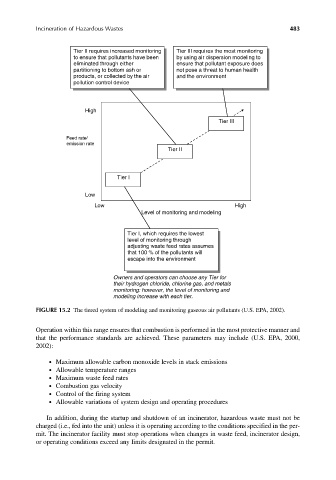Page 512 - Materials Chemistry, Second Edition
P. 512
CAT3525_C15.qxd 1/27/2005 12:40 PM Page 483
Incineration of Hazardous Wastes 483
Tier II requires increased monitoring Tier III requires the most monitoring
to ensure that pollutants have been by using air dispersion modeling to
eliminated through either ensure that pollutant exposure does
partitioning to bottom ash or not pose a threat to human health
products, or collected by the air and the environment
pollution control device
High
Tier III
Feed rate/
emission rate
Tier II
Tier I
Low
Low High
Level of monitoring and modeling
Tier I, which requires the lowest
level of monitoring through
adjusting waste feed rates assumes
that 100 % of the pollutants will
escape into the environment
Owners and operators can choose any Tier for
their hydrogen chloride, chlorine gas, and metals
monitoring: however, the level of monitoring and
modeling increase with each tier.
FIGURE 15.2 The tiered system of modeling and monitoring gaseous air pollutants (U.S. EPA, 2002).
Operation within this range ensures that combustion is performed in the most protective manner and
that the performance standards are achieved. These parameters may include (U.S. EPA, 2000,
2002):
● Maximum allowable carbon monoxide levels in stack emissions
● Allowable temperature ranges
● Maximum waste feed rates
● Combustion gas velocity
● Control of the firing system
● Allowable variations of system design and operating procedures
In addition, during the startup and shutdown of an incinerator, hazardous waste must not be
charged (i.e., fed into the unit) unless it is operating according to the conditions specified in the per-
mit. The incinerator facility must stop operations when changes in waste feed, incinerator design,
or operating conditions exceed any limits designated in the permit.

